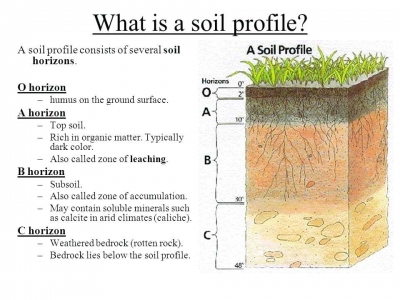
Soil is made up of broken rocks, minerals, decaying plants and animals, tiny creatures, gases, and water. If a section is cut through soil, you will see many layers. The depth of the layers vary in different soils.
Humus:
Humus, nonliving, finely divided organic matter in soil, derived from microbial decomposition of plant and animal substances. Humus, which ranges in colour from brown to black, consists of about 60 percent carbon, 6 percent nitrogen, and smaller amounts of phosphorus and sulfur. As humus decomposes, its components are changed into forms usable by plants.
Topsoil:
It is also called the humus layer, which is rich in organic material. This layer consists of decomposed material and organic matter. This is the reason; the topsoil has a dark brown color. The hummus makes the topsoil soft, porous to hold enough air and water. In this layer, the seeds germinate and roots of the plants grow. Many living organisms like earthworms, millipedes, and centipedes, bacteria, and fungi are found in this layer of soil.
Leaching layer:
Leaching, loss of soluble substances and colloids from the top layer of soil by percolating precipitation. The materials lost are carried downward (eluviated) and are generally redeposited (illuviated) in a lower layer. This transport results in a porous and open top layer and a dense, compact lower layer. The rate of leaching increases with the amount of rainfall, high temperatures, and the removal of protective vegetation. In areas of extensive leaching, many plant nutrients are lost, leaving quartz and hydroxides of iron, manganese, and aluminum. This remainder forms a distinctive type of soil, called laterite, or latosol, and may result in deposits of bauxite. In such areas rapid bacterial action results in the absence of humus in the soil, because fallen plant material is completely oxidized and the products are leached away. Accumulations of residual minerals and of those redeposited in lower layers may coalesce to form continuous, tough, impermeable layers called duricrusts.
Weathered rock:
Weathering is the name given to the process by which rocks are broken down to form soils. Rocks and geological sediments are the main parent materials of soils (the materials from which soils have formed). There is a very wide variety of rocks in the world, some acidic, some alkaline, some coarse-textured like sands, and some fine-textured and clayey. It is from the rocks and sediments that soils inherit their particular texture. When you see rocks in the landscape it is easy to appreciate how long the process of breaking down rocks to form soil takes. In fact, it can take over 500 years to form just one centimetre of soil from some of the harder rocks. Fortunately, in some respects at least, huge amounts of rocks were broken down during the Ice Age over 10,000 years ago and converted into clay, sands or gravels, from which state it was easier to form soils.
Subsoil:
It is comparatively harder and compact than topsoil. It is lighter in color than the topsoil because there is less humus in this layer. This layer is less organic but is rich in minerals brought down from the topsoil. It contains metal salts, especially iron oxide in a large proportion.
Picture Credit : Google

